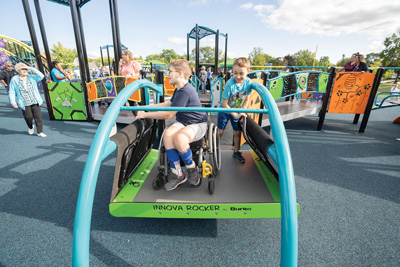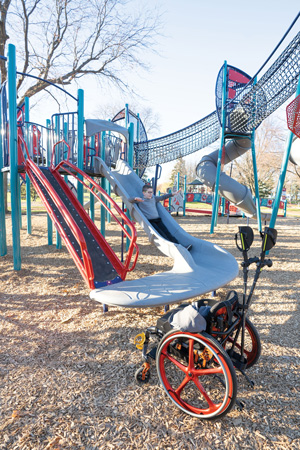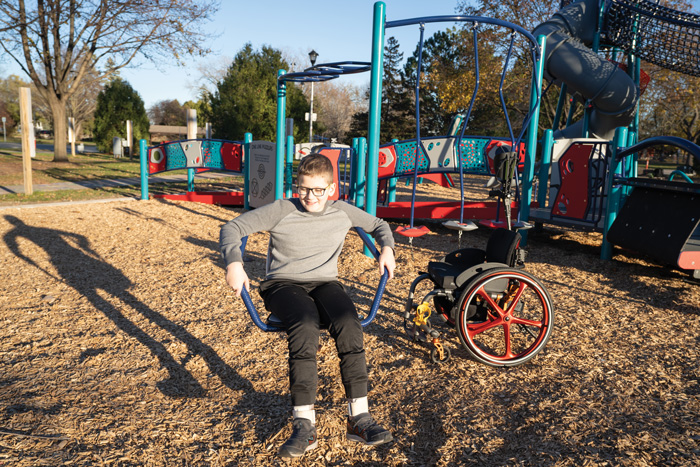Playgrounds, recreation and outdoor fitness spaces help communities get outside, get moving and develop skills, relationships, resilience, and a sense of adventure and community, that transcend the playspace. Making certain everyone not only has access but can fully participate in an equitable play experience is one of the most important aspects of playground design.
Q. Why is inclusion important in outdoor spaces?
A. At the base level, it’s the law. ADA requirements state that access to public recreation is a civil right. It’s also important because we know that play is a catalyst for learning, growing, developing and engaging in the community. Creating spaces that bring everyone together requires considering who the “everyone” is and approaching design listening to the voices, needs and preferences of all people. According to the CDC, 10% of children ages 6 to 14 and 13% of adults have differing abilities. Having spaces that accommodate the entire community will create an equitable outdoor experience for everyone.
Q. What should we consider as we design inclusive spaces?
1. Parallel pathways for play. How children get around the space is hugely important, and access to the most exciting elements is a must for inclusion. Having pathways that allow people of different ages and abilities to play and learn alongside one another and create their own play experiences in and around the play environment is part of fostering understanding and plays a role in decreasing attitudinal barriers people with differing abilities often face.
2. Play variety. Variety is the spice of play, and having different types of play experiences is crucial to inclusion. Variety means everyone can create an experience that meets their needs, abilities and preferences and that no one is stigmatized into only certain types of play. For example, children who don’t transfer from mobility devices should be able to, in an inclusive space, participate in creative play, musical play, sensory play and spinning and have comfortable places to socialize and rest. Caregivers should be able to engage comfortably with the children and participate in intergenerational play.
3. Play equity. Similar play experiences for all children, representation of different cultures, races and abilities, access to different types of play, spaces that foster comfort, learning, socialization and development are all contributors to play equity. Providing all children access to the most used and exciting aspects of play is an important part of equity and, as an example, the “Circle of Play”—defined as climbing up and sliding down and then doing it again and again—is the most common way we see children playing on a playground structure. Creating a space where there is a transfer option for children using mobility devices, and ensuring they can transfer independently, allows participation in the full play experience. Other examples include teaching history through custom play experiences, having multiple ways to swing and spin and providing different climbing opportunities for children of different ages and developmental stages.
different types of play, spaces that foster comfort, learning, socialization and development are all contributors to play equity. Providing all children access to the most used and exciting aspects of play is an important part of equity and, as an example, the “Circle of Play”—defined as climbing up and sliding down and then doing it again and again—is the most common way we see children playing on a playground structure. Creating a space where there is a transfer option for children using mobility devices, and ensuring they can transfer independently, allows participation in the full play experience. Other examples include teaching history through custom play experiences, having multiple ways to swing and spin and providing different climbing opportunities for children of different ages and developmental stages.
Q. Anything else you would like to share?
A. Yes, it’s important to not just consider abilities but also preferences. Considering preferences is the next level of inclusion and digs deeper into the needs of the people using the space. Sensory processing, vision, developmental, physical differences and more are all considerations when we design community spaces. Understanding the population and providing a space that everyone feels is designed with them in mind will drive usage, engagement and advocacy around the space.
For More Information
BCI Burke
800-266-1250
www.bciburke.com



